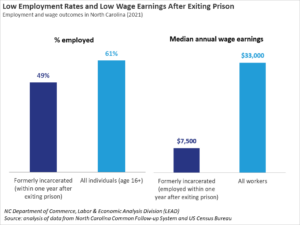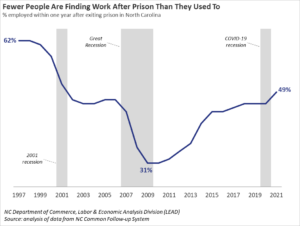The North Carolina Department of Commerce has created a new online tool called The NC Reentry Outcome Reporting System. The tool shows employment outcomes for people leaving the state prison system. The numbers are sobering. I had a chance to talk to one of the tool’s architects, Andrew Berger-Gross, Senior Economist at the Department’s Labor & Economic Analysis Division. Here’s a snippet of our conversation, in question-and-answer format.
Why is it important for folks to understand employment outcomes for people exiting the prison system?
Our mission at the Department of Commerce is to improve the economic well-being of all North Carolinians, and, of course, “all North Carolinians” includes those returning home from prison.
Recidivism—or re-offending—is an all-too-common outcome for those leaving prison, and we know from academic research that finding a good job can be a powerful deterrent to re-offending.
As the old adage goes, you can’t manage what you don’t measure. Tracking the employment outcomes of formerly incarcerated people is an essential first step toward developing policies and programs to improve the economic well-being of this population and reduce their likelihood of recidivism, leading to a safer and more prosperous North Carolina for all of us.
What kinds of things does the tool show?
The tool shows how many people find jobs after leaving prison, how much money they earn, and the industry sectors where they work, among other things. Users can see these data points broken out by gender, race, year of release (what we call a “cohort”), and participation in a prison job or an education or training program.
Because we have data going back to 1997, users can follow employment outcomes for more than twenty-five years after the initial release dates for people leaving prison. Users also can compare outcomes across cohorts—for example, they can compare the outcomes of people released in the 1990s to those released more recently.
What does the tool tell us about how many people find jobs after leaving prison?
People exiting prison have low employment rates and very poor wage earnings. Only 49% of people released from North Carolina state prisons in 2021 were employed within a year after release, compared to a 61% employment rate for the broader population. Those lucky enough to find work after prison earned a median wage of only around $7,500 per year–much lower than the statewide median wage and well below the federal poverty line.

Employment outcomes vary with the business cycle: people typically have trouble finding work when the economy is in recession and are more likely to find work when the economy is growing. Indeed, post-release employment rates in North Carolina bottomed out at 31% in 2009 during the depths of the Great Recession and improved as the economy recovered. But even during what was arguably the tightest labor market on record, people exiting prison in 2021 were less likely to be employed than they were back in 1997, when 62% found work after prison.

Do these outcomes vary by demographics?
Yes, to some extent. For example, men and women leaving prison tend to have similar rates of employment after release, but men typically find higher-paying work than women.
The variation in outcomes by race is particularly interesting. Black people are disproportionately represented in our prison system: in 2021, they made up 51% of people incarcerated in North Carolina state prisons, more than double their 20% share of the overall statewide population. But when looking at employment outcomes, we see that black people getting out of prison were more likely to find work than their white counterparts. In fact, the trend of declining employment rates since the late 1990s has been almost entirely accounted for by the deteriorating outcomes of white people leaving prison.
That said, it’s important to acknowledge that all individuals face challenges finding gainful employment after prison, regardless of their race or gender.
Where do the data come from?
The tool uses information from the NC Common Follow-up System, a repository of workforce and education information maintained collaboratively by several state agencies to track the employment outcomes of people exiting North Carolina prisons.
The tool shows data for a very specific segment of the justice-involved population—can you explain that?
Correct. The tool only looks at employment outcomes for people who were incarcerated in a North Carolina state prison. We are currently unable to track the outcomes of others in the justice-involved population, such as people who served a sentence in a federal prison or county jail; people charged with but not convicted of a crime; people who were convicted but not sentenced to incarceration in prison; and people released from a prison outside North Carolina.
If folks want to check out the tool, where can they find it?
They can access it here.
Are any improvements or enhancements planned or underway?
Absolutely. We view this tool as a work in progress. The underlying data contain almost endless possibilities for measuring and reporting on the outcomes; the current version only scratches the surface. We plan to enhance the tool in the future with additional reentry outcomes and more reporting categories for slicing and dicing these data.
However, before we do that, we want to understand how the tool is being used and which functionalities are more (or less) valued by users. Thus, I encourage users to get in touch with suggestions for improving the tool. Is there anything you want added or dropped? Let me know, and we will consider your feedback as we introduce further improvements to this resource. Folks can reach me by email at andrewbg@commerce.nc.gov.